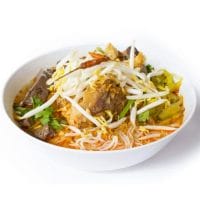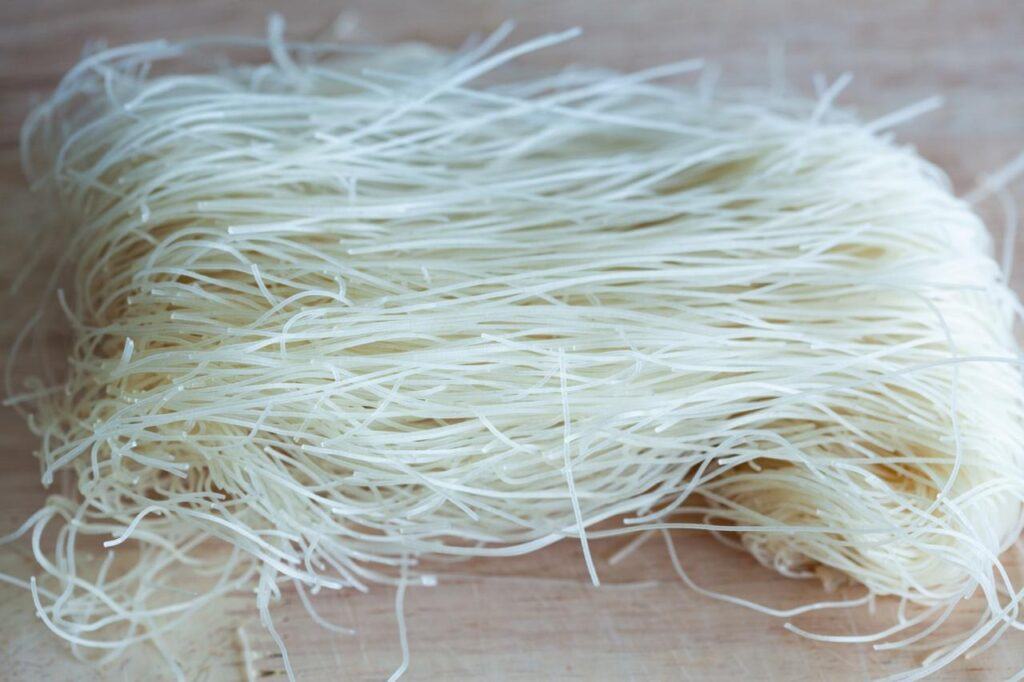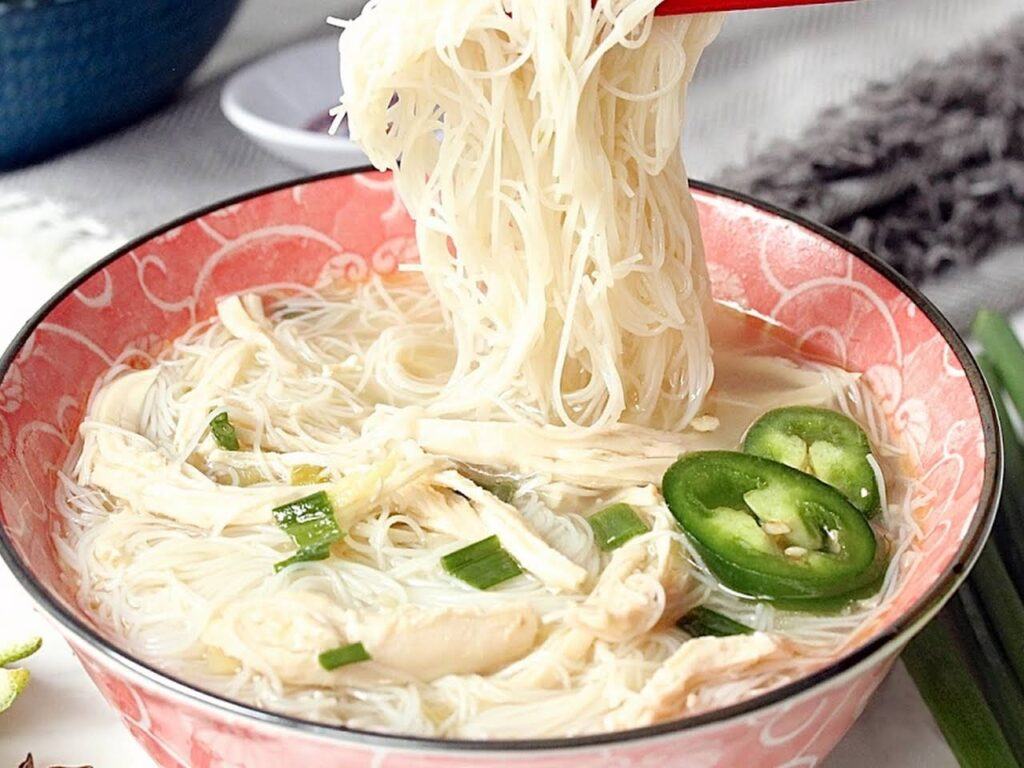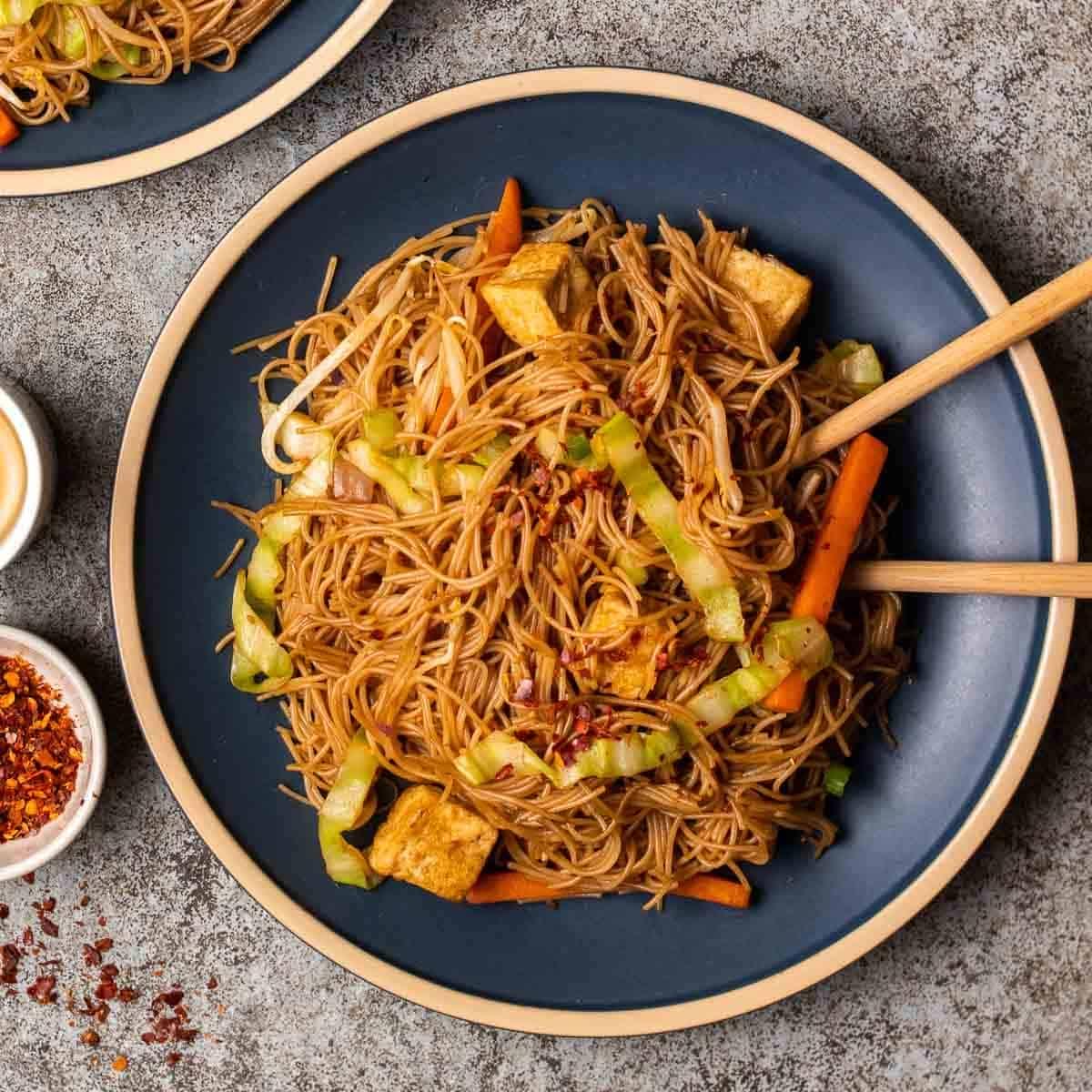Oh, dear food lovers, it’s been quite the adventure, hasn’t it? Today, I’m diving deep into the recesses of my recipe book to unearth a treasure. Over the years, there’s a particular dish that has become a signature of mine – the Crispy Vermicelli Rice Noodles. I remember, on a breezy evening in Thailand, a local chef whispered this recipe into my ears, insisting that it was the heart and soul of their culinary tradition.
These Thai crispy, puffed rice noodles are so fragile but so good! You will often find them served as a side dish at an Asian restaurant or topped on salads or any other meals or appetizers. These noodles are light, puffy and with just a pinch of salt, they can even be served as a snack on it’s own. Let’s see how to make this Crispy Rice Noodles
Crispy Rice Noodles Recipe


Crispy Vermicelli Rice Noodles
Equipment
Ingredients
Ingredients
- Lettuce
- Vermicelli rice noodles
- Canola oil
- Salt
Instructions
- Cut the dried vermicelli rice noodles into 4-5 inch lengths.
- Put the wok over a medium-high flame and pour the ¾ cup of canola oil. Heat up the oil which will take for about 1 minute. To test if your oil is truly ready, put the end of 3 noodle strands into the oil. If the ends quickly puff up, then the oil is ready; otherwise, it is not.
- Gently drop the noodles into the hot oil. Put noodles per batch so that it can be easier for you to monitor them. It only takes 5 seconds for one side to be cooked. After 5 seconds, flip onto the other side and wait. You’ll know that they’re cooked once they turned white and puffy. Remove the noodles using a slotted spoon or tongs and transfer on a plate lined with paper towels. The paper towels will absorb the excess oil and will render your noodles not too oily.
- Do the same procedure in Step no. 3 for the rest of the noodles.
- You can opt to sprinkle salt on the noodles or just leave them be. Serve the noodles with the lettuce and enjoy with every crunchy bite.
Video
Notes
- For the best rice noodles, I recommend the brands without starch.
- There are proper techniques involved in Chinese stir-frying.
- Make sure your wok and skillet is fully heated on high heat. As soon as smokes swirl out of a wok or skillet, it’s ready.
- Serve this vermicelli noodle bowl as a main dish or with other dishes.
Nutrition
© Food And Meal
This website provides approximate nutrition information for convenience and as a courtesy only. Nutrition data is gathered primarily from the Spoonacular Database, whenever available, or otherwise other online calculators.
Baking the Crispy Vermicelli Rice Noodles: An Oven-Based Delight
Using the oven is an ingenious way to achieve that desired crispiness without indulging in deep-frying. The even heat distribution of the oven allows the vermicelli noodles to achieve a perfect golden hue.
Ingredients:

- Vermicelli rice noodles, soaked in water for 20 minutes
- Cooking spray or a brush of olive oil
- Salt to taste (optional)
Method:
- Preheat: Start by preheating your oven to 375°F (190°C). While it’s getting warmed up, let’s prep the noodles.
- Drain and Dry: After soaking the vermicelli rice noodles for about 20 minutes, ensure you drain them thoroughly. Lay them out on a clean kitchen towel and pat dry to remove any excess moisture. This step is crucial because any extra moisture will prevent the noodles from becoming crispy in the oven.
- Line and Spread: Line a baking sheet with parchment paper. This prevents the noodles from sticking and allows for easy cleanup. Spread the drained and dried vermicelli noodles in a single, even layer on the sheet. Ensure they are not clumped together.
- Light Oil Brushing: Either spray a light coat of cooking spray over the noodles or lightly brush them with olive oil. This will help in achieving a crispy texture and a beautiful golden color. If you wish, you can sprinkle a pinch of salt over them at this stage.
- Bake: Place the baking sheet in the preheated oven and bake for 10-12 minutes. It’s essential to check them after the 8-minute mark to ensure they aren’t browning too quickly. The goal is to have them golden and crispy, not overly browned.
- Cool and Serve: Once done, remove from the oven and let them cool on the baking sheet for a few minutes. They will continue to crisp up a bit more as they cool. Once cooled, serve immediately with your choice of dip or accompaniment!
The oven-baked method not only gives a healthier twist to our beloved Crispy Vermicelli Rice Noodles but also ensures an even, delightful crispness that will surely make you come back for seconds. Enjoy!
Tips for making Thai Vermicelli Rice Noodles

Serving Suggestions
Ah, the moment of plating! How and when you serve these Crispy Vermicelli Rice Noodles can truly elevate the experience. Here are some thoughts:
- Occasions and Audience: These crispy wonders are incredibly versatile. They make for perfect appetizers at dinner parties or can act as an exotic side dish at a weekend brunch. Given their lightness, they’re a hit with both kids and adults.
- Complementary Sides: Pair these noodles with a tangy tamarind sauce or a spicy chili dip. They also harmonize well with simple stir-fried veggies or grilled tofu for vegetarians, and perhaps a side of grilled shrimp or chicken for the meat-lovers.
- Garnish Ideas: A sprinkle of freshly chopped cilantro or green onions can add a splash of color and freshness. A light drizzle of sesame oil and a sprinkle of sesame seeds can enhance the flavor profile.
- Beverage Pairings: A cold, crisp glass of Sauvignon Blanc or an aromatic Jasmine tea pairs wonderfully, complementing the lightness of the noodles.
- Variations in Serving: Consider serving these crispy delights in small individual bowls topped with some stir-fried veggies and protein of your choice, almost like a noodle salad. Another fun way? Roll them in lettuce wraps with some spicy tofu or chicken strips.
Cooking Tips

Mastering the art of crispy vermicelli isn’t just about the recipe; it’s about the nuances:
- Even Spread: When placing the noodles on a baking sheet, ensure they’re evenly spread. Clumping will prevent them from crisping up uniformly.
- Watch the Oven: Every oven is unique, and its temperament can vary. It’s vital to keep a close watch, especially during the latter half of the baking time, to prevent over-browning.
- Soaking Matters: Under-soaking might leave them too hard, while over-soaking can make them soggy. Stick to the recommended soaking time for that optimal texture.
- Common Mistakes: Avoid using too much oil. A light spray or brush is all you need. Excess oil can leave the noodles greasy rather than crispy. Also, refrain from seasoning heavily before baking. Over-seasoning can overpower the delicate nature of the noodles.
FAQs about Thai Crispy Vermicelli Rice Noodles
1. Can I use regular noodles instead of rice vermicelli? While regular noodles can be used, rice vermicelli offers a unique texture and crispiness when baked. If you use regular noodles, the result will be slightly different in both taste and texture.
2. How do I store leftovers? Place the cooled crispy vermicelli in an airtight container. They should remain crispy for a day or two. If they lose some of their crunch, a quick reheat in the oven for 2-3 minutes should revive them.
3. Can I add flavors or seasonings directly to the noodles before baking? Yes, but be cautious. While light seasonings can be added, heavy or liquid-based seasonings can prevent the noodles from crisping up.
4. Is there a gluten-free version of this dish? Absolutely! Rice vermicelli is naturally gluten-free. Just ensure that any sauces or dips you pair with it are also gluten-free.
5. Can I make these noodles spicy? Certainly! Consider adding a dash of chili flakes or a light sprinkle of cayenne pepper before baking to give them a kick. Just remember, a little goes a long way!
and meal crispy rice noodle Recipes .
Experience the culinary brilliance of Chef John at Food And Meal Restaurant. With over 20 years of global expertise, My innovative creations and unwavering dedication to cooking have earned me a well-deserved reputation. My passion for gastronomy is showcased in every dish, combining fresh, local ingredients with harmonious flavors and captivating presentations. My ability to tell a story through my food reflects my profound understanding of culture and emotion.




